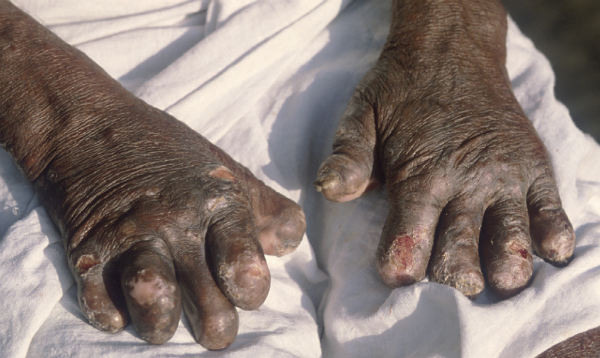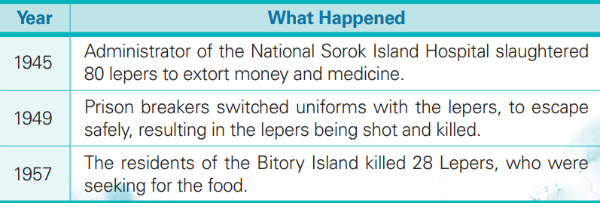Sorok Island is in Goheung, Jeolla Province. Unlike the beautiful name Sorok, which means small deer in Korean, the painful stories of lepers lay in Sorok Island. As many lepers were isolated on Sorok Island, the traces of their lives are still easily found throughout the Island. Jo Sung-Ryong, a Professor of Architecture at SKKU, asserts that Sorok Island should be preserved, to remember the tragic history of the lepers. From this article, the Sungkyun Times (SKT) reveals how lepers were discriminated against and why their history should be remembered.
Explanation of Leprosy
What is leprosy?
Leprosy, also known as Hansen’s disease in Korea, is an infectious disease which attacks the nerves, skin, eyes and even respiratorytract. It is a contagious disease, but surprisingly, it is not easily spread as 95% of every person on Earth is naturally resistant to the disease. Leprosy is not inherited and is also not spread through sexual contact. Once a person is infected, the virus can remain dormant for between five to 20 years and then the symptoms, suchas numbness, start to appear. The bacteria attack the peripheral nerves, which causes athletic abilities to decline. When the infection becomes more severe, the body parts may also become deformed. Currently, thanks to the development of medical technology, leprosy can be completely cured with medicine.

Leprosy in Korea
The total number of patients with leprosy in Korea in 2015 was 10,853. Many of these people tended to have disabilities causedby leprosy. Moreover, as most of them are the elderly, the numberis decreasing year after year because of their natural death. In Korea, about five people per year are infected.

About half of the lepers in Korea live in settlements or in hospitals, which are out of public view. They are not only isolated from society, but also from their own families. Most of the settlements are located around the farming regions and offer inadequate environments for them to live in. Furthermore, most lepers suffer from financial difficulties because they mostly do not have jobs. The government supports the infected by offering them living expenses, but still, they have a hard time sustaining their lives with such a small budget.
The perception that people have of lepers still has not really changed yet. Hatred and fear towards them are rampant throughout society. Since many people think that the disease is not curable and that it is highly infectious, they want as little contact as possible, and that causes lepers to gather together in settlements and hospitals in order to hide from “normal people”. So why do people think that leprosy is so deadly compared to other contagious diseases? The only explanation is that people are repelled by the appearances of lepers.
The History of Discrimination toward Lepers
Isolation of Lepers
During the Japanese colonial era, lepers were isolated on Sorok Island. The Japanese built the National Sorok Island Hospital, and isolated the patients there. The Japanese violated human rights severely. For example, pregnant women with Leprosy were forced to abort their babies, even though leprosy is not hereditary. Currently about 550 patients are living on Sorok Island, but most of them are perfectly cured. The reason they still live on Sorok Island is that they need continuous treatment to prevent any after effects from leprosy. They also stay on Sorok Island, because they have been isolated for so long, resulting in complete separation from society and even sometimes from their own families.
Discrimination by the Government
In 1961, the Government forced the Lepers to work for the reclamation of Omi Island. The Government promised the lepers to provide residence in Omi Island, but after the reclamation was finished, the government broke the promise, and did not accept lepers to reside their. Consequently, the lepers were used by the government as a source of workforce and received nothing in return. All that was left were the isolation and the violation of the human rights. Moreover, the Government put an excessive amount of control on the lepers as well. The lepers were treated as ‘potential criminals’ who had a deadly disease which was highly infectious. The lepers, who had to be protected and treated medically, were severely monitored and controlled in the name of public safety. After the mid 1970’s, the government created the Hansung Cooperation, which is a cooperation for lepers, to prevent them from becoming criminal.
Tragedy: Slaughter of the Lepers
There were lots of crimes committed against the lepers, based on hatred and the violation of human rights.

These crimes were based on pure hatred, which makes it more immoral. The violence toward the lepers made them hide from society and isolate themselves from people without disease who may threaten their lives.
Discrimination against Leprosy in Modern Society
In modern Korea, lepers still experience distinction and social negligence. It is still difficult for lepers to live freely even today.
Unpaid Compensation from the Government
Although lepers suffer due to the government’s past faults, the Korean government does not admit this fact and give any compensation for their fault. Different from Korea, however, the Japanese government paid compensation to victims of leprosy discrimination. In Japan, a group of lepers filed a suit for compensation. The Japanese court reached a verdict that their government should compensate lepers. The Korean government established a fact-finding committee and found 6,400 victims in 2009. Those who were found by the committee filed a suit against the Korean government. In April, 2014, the court decided to pay compensation to lepers for vasectomy and abortion operations. However, the government appealed against the decision claiming that vasectomy and abortion operations were not illegal because they were carried out with the consent of the patients and that the plaintiffs’ rights to claim compensation had already expired. In contrast, the Japanese government fully admitted its past fault in 2001. The Taiwanese government also made a special law that was designed to compensate lepers.
Lepers in Korea were shocked by the government’s irresponsible attitude different from the Japanese and Taiwanese governments. In 2014, accordingly, the members of the National Assembly proposed a law, the Investigation into the Truth of the Hansen Victims and Life Support to Victims. However, the law was ineffective in that the government just provided consolatory payments without acknowledging the obligation to compensate for illegal acts. In 2016, the lawmakers proposed a special law, the Investigation into the Truth of the Hansen Victims and Compensation, which was revised and requested the right to demand compensation. Nevertheless, the government did not announce the official position. In 2017, however, the Supreme Court first reached a verdict that the government holds the responsibility for abusing the basic human rights of the lepers. This verdict is expected to influence a positive impact on lawsuits for compensation for lepers.
Incomplete Governmental Support
Absence of compensation is not the only problem they are facing. The government also does not support the lepers adequately. The Ministry of Health and Welfare made a budget to support them in 2015. They budgeted 700 million for investigating the damage caused by leprosy, supporting lepers’ lives and using it for various aspects such as personnel expenses and operation costs. However, almost 30% of the budget was not used. This is because there is no absolute standard for providing compensation. Although the government established the Seeking Truth of Hansen’s Victims committee, the committee also does not have a standard for compensation and provides only 150,000 per patient per month.
Social Discrimination
The negative image of lepers portrayed by the media also influenced people’s cognition of the lepers. Even today, people use terms related to leprosy which imply human rights violation. Although lepers are completely cured, they are called ‘people who suffer from leprosy’. Other infectious cases are not referred to as people who have a medical history of that disease. They are just referred to as ‘healthy’ people. For example, in the case of tuberculosis patients, they are not distinguished as people who suffer from tuberculosis. According to the government, leprosy is not a serious infectious disease. Thus, it does not make sense to label people who are completely cured from the disease as ‘people who suffered from leprosy’. After recovering from the disease labeling people with the term ‘victims of leprosy’ is not right.
Need to Remember Lepers and Cases
There are several reasons as to why we should remember leprosy. By remembering the disease, the public can not only console the victims but also appreciate the historical significance. We can look back into the past and check today’s administration of leprosy, and then the necessity for future measures for victims will emerge. In Korea, social minorities such as the disabled and foreign workers experience social discrimination in a similar way as the lepers did in the past. By remembering their painful history, we need to learn respect for human rights, honor the nobility of our citizens, cultivate the sophistication of democratic citizens and also try to achieve social integration.
Remembering Sorok Island Project by Professor Jo Seong-Ryong
SKKU Professor Jo from the Department of Architecture developed the ‘Remembering Sorok Island’ project. Sorok Island reflects the most coercive supervision system of lepers. The average age of the lepers on Sorok Island is 74 years old. This is the reason the professor argued that Sorok Island needed to be preserved. On Sorok Island, we can see the lifestyle of lepers. They built their houses themselves. Through the project, Professor Jo wanted the public to remember lepers’ tough lives. This can possibly prevent Sorok Island from becoming a commercial tourist attraction, and finally it will be a springboard to respect the human rights of minorities.

Kalaupapa National Historical Park
The case of Kalaupapa, an island belonging to the United States (US), is similar to Sorok Isalnd in that it is a place where the lepers were forced to move because of their illness. There was a time when up to 1,200 people were living in the island, but now there are only nine people there. In 1980, President Jimmy Carter appointed Kalaupapa as a national historical park to preserve the lepers’ life styles. The public could easily approach and contribute to the spread of memorial services, which made it possible to understand and remember leprosy and its victims in earnest. Likewise, Korea also has to support the Remembering Sorok Island project at the national level. From this, we can learn about the history of leprosy and the discrimination against it, which will ultimately help us overcome such discrimination and consider social minorities.
Even until today, lepers are still discriminated against and neglected by the public. Although there are declining numbers of lepers these days, we need to remember the history of leprosy and also consider social minorities. Remembering all social minorities who are discriminated against will lead to a more integrated society. In addition, we can look back into the past, and need to think about future measures for victims who are facing hardship under people’s negligence.
